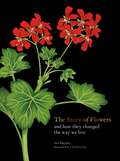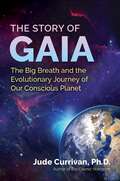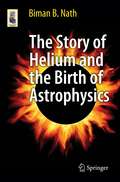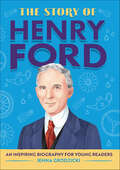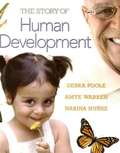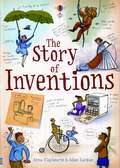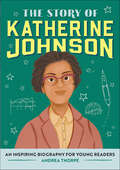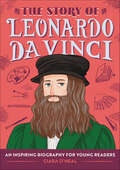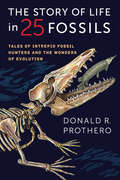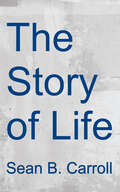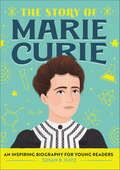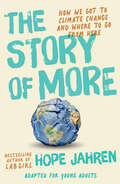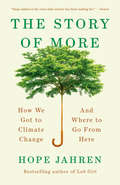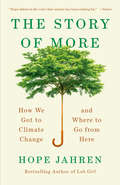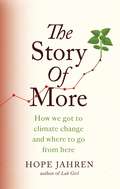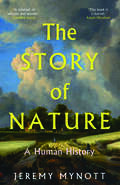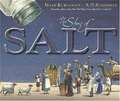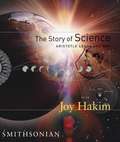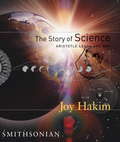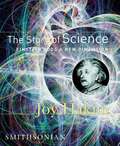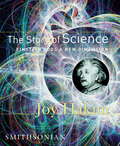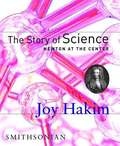- Table View
- List View
The Story of Flowers: And How They Changed the Way We Live
by Noel KingsburyThroughout history flowers have been an integral part of human survival and culture – as food, for medicine, to express feelings, as symbols, to commemorate and celebrate, and to decorate. Their shapes, colours, scents and textures have always attracted us, as they do animals and insects. Flowers are used as luxury spices (saffron), and as colouring and flavouring agents – marigolds fed to chickens make eggs more yellow and lavender was Elizabeth I’s favourite flavour of jam. Flowers are full of symbolic meaning: violets represent modesty, daises purity and daffodils unrequited love. And they have always played an important role in culture through myths and legends, literature and the decorative arts. This delightful new book brings together 100 of the world’s flowers to tell their remarkable stories. Each flower is richly illustrated in colour and accompanied by facts about each species and what role it has played in our culture and history.
The Story of Flowers: And How They Changed the Way We Live
by Noel KingsburyThroughout history flowers have been an integral part of human survival and culture – as food, for medicine, to express feelings, as symbols, to commemorate and celebrate, and to decorate. Their shapes, colours, scents and textures have always attracted us, as they do animals and insects. Flowers are used as luxury spices (saffron), and as colouring and flavouring agents – marigolds fed to chickens make eggs more yellow and lavender was Elizabeth I’s favourite flavour of jam. Flowers are full of symbolic meaning: violets represent modesty, daises purity and daffodils unrequited love. And they have always played an important role in culture through myths and legends, literature and the decorative arts. This delightful new book brings together 100 of the world’s flowers to tell their remarkable stories. Each flower is richly illustrated in colour and accompanied by facts about each species and what role it has played in our culture and history.
The Story of Gaia: The Big Breath and the Evolutionary Journey of Our Conscious Planet
by Jude Currivan• Examines our emergence as self-aware members of a Universe that is itself a unified and innately sentient entity that exists TO evolve• Shares leading-edge scientific breakthroughs and shows how they support traditional visions of Earth as a living being--Gaia• Rewrites evolution as not driven by random occurrences and mutations but by intelligently informed and meaningful information flows and processesExploring our emergence as self-aware members of a planetary home and entire Universe that is a unified and innately sentient entity, Jude Currivan, Ph.D., shows that mind and consciousness are not what we possess but what we and the whole world fundamentally are. She reveals our Universe as &“a great thought of cosmic mind,&” manifesting as a cosmic hologram of meaningful in-formation that, vitally, exists to evolve. Sharing scientific breakthroughs, the author details the 13.8 billion-year story of our Universe and Gaia, where everything in existence has inherent meaning and evolutionary purpose. Showing how the Universe was born, not in an implicitly chaotic big bang, but as the first moment of a fine-tuned and ongoing &“big breath,&” she shares the latest evidence for the innate sentience that has guided our universal journey from simplicity to ever-greater complexity, diversity, and self-awareness--from protons to planets, plants, and people. She explains how evolution is not driven by random occurrences and mutations but by profoundly resonant and harmonic interplays of forces and influences, each intelligently informed and guided.In Gaia, the Universe&’s evolutionary impulse is embodied in collaborative relationships and dynamic co-evolutionary partnerships on a planetary scale and as a wholistic gaiasphere. She reveals how the conscious evolution of humanity is an integral part of Gaia&’s own evolutionary progress and purpose. By perceiving and experiencing our planet as a sentient being and ourselves as Gaians, we open ourselves to a deeply ecological, evolutionary, and, above all, hopeful worldview.
The Story of George Washington Carver
by Eva MooreWhen he was 7, George had a secret garden in the woods, where he took care of sick and dying plants. He knew so much about plants, they called him the Plant Doctor. This is his true story.
The Story of Helium and the Birth of Astrophysics
by Biman B. NathWhat if one of the most thrilling stories in the history of science turned out to be wrong? Can urban legends creep into the hallowed grounds of scientific history? As incredible as it may sound, the story of one of the most important elements in modern times - helium - has been often misrepresented in books, encyclopedias, and online sources, despite the fact that archival materials tell a different story. Open the entry for Helium in any encyclopaedia and you will read a false story that has been repeated over the years. 'Encyclopaedia Britannica', for example, says that helium was discovered by the French astronomer Pierre Janssen while observing a total solar eclipse from India in 1868. Apparently he noticed something new in the spectrum of the sun, which he thought was the signature of an undiscovered element. The truth is that Janssen never saw any sign of a new element during his observations in India. His reports and letters do not mention any such claim. Other sources would have you believe that helium was jointly discovered by Janssen and Norman Lockyer, a British scientist, and that their discovery letters reached Paris the same day, one sent from India, and the other from England. Again, the truth is completely different. Two letters from Lockyer and Janssen did reach Paris the same day in 1868, but their letters did not mention any new element. What they had discovered was a new way of observing the Sun without a solar eclipse. This would ultimately lead to the discovery of helium, in which Lockyer would play a prominent role, but not Janssen. At the same time, Norman Robert Pogson, a disgruntled British astronomer stationed in India did notice something peculiar during the eclipse. He was the first one to notice something odd about the spectrum of the Sun that day, and his observations would prove crucial to Lockyer's own investigations of helium. But Pogson's report was never published in any peer reviewed journal and it languished on the desk of a local British officer in colonial India. This book tells the real story behind the discovery of helium, along with biographical sketches of the scientists and descriptions of the milieu in which they worked. It will convey the excitement, confusion, and passion of nineteenth century scientists, using their own words, from their letters and reports. "The Story of Helium and the Birth of Astrophysics" chronicles one of the most exciting discoveries ever made and explains why it also marked the birth of a new branch of science called 'astrophysics.'
The Story of Henry Ford: An Inspiring Biography for Young Readers (The Story of Biographies)
by Jenna GrodzickiDiscover the life of Henry Ford—a story about putting the world on wheels for kids ages 6 to 9 Henry Ford was the founder of Ford Motor Company and the inventor of the Model T, the car that changed the way many Americans lived. Before he became a pioneer in the auto industry, Henry was a young boy who loved to take things apart and figure out how they worked. When he grew up, he invented creative new ways to assemble cars and made them more affordable for the first time. This Henry Ford biography for kids explores how he went from being a curious child to a successful businessman and inventor.Independent reading—This Henry Ford biography is broken down into short chapters and simple language so kids 6 to 9 can read and learn on their own.Critical thinking—Kids will learn the Who, What, Where, When, Why, and How of Henry's life, find definitions of new words, discussion questions, and more.A lasting legacy—Find out how Henry Ford made a mark on the world that we still see today.How will Henry Ford's hard work and innovative spirit inspire you?Discover activists, artists, athletes, and more from across history with the rest of the Story Of series, including famous figures like: Leonardo da Vinci, the Wright Brothers, Katherine Johnson, Neil Armstrong, and Marie Curie.
The Story of Human Development (1st edition)
by Debra A. Poole Narina Nunez Amye WarrenThe book presents fascinating details and descriptions of human development throughout the lifespan with a narrative infused with the rich and diverse stories of people's lives, the compelling organization, a unique connecting summaries and focus on guiding developmental principles. This text puts the science of human development into a framework that better explains and explores how a whole person develops within varying environmental contexts.
The Story of Inventions
by Anna ClaybourneToasters, toilets and televisions, computers, cars and chocolate bars, flying machines and even your jeans. All these everyday things and many more are only here because someone bothered to invent them. This book reveals the real-life stories and bright sparks behind dozens of brilliant inventions.
The Story of Katherine Johnson: An Inspiring Biography for Young Readers (The Story of Biographies)
by Andrea ThorpeDiscover the life of Katherine Johnson—a story about reaching for the stars, for kids ages 6 to 9 Katherine Johnson was one of the best mathematicians in the history of the United States. Before her math skills helped send the first American astronauts safely into space, she was a smart and curious girl who loved to learn new things about the world around her. She studied hard in school and became one of the first Black women hired by NASA.Independent reading—This Katherine Johnson biography is broken down into short chapters and simple language so kids 6 to 9 can read and learn on their own.Critical thinking—Kids will learn the Who, What, Where, When, Why, and How of Katherine's life, find definitions of new words, discussion questions, and more.A lasting legacy—Find out how Katherine went from being a young girl growing up in West Virginia to one of the most important people in space exploration.How will Katherine's out-of-this-world achievements inspire you?Discover activists, artists, and athletes, and more from all across history with the rest of The Story Of series, including famous figures like: Sojourner Truth, Martin Luther King Jr., John Lewis, Ruby Bridges, and Barack Obama.
The Story of Leonardo da Vinci: An Inspiring Biography for Young Readers (The Story of Biographies)
by Ciara O'NealDiscover the life of Leonardo da Vinci—a story about uncovering new things for kids ages 6 to 9Leonardo da Vinci was a famous artist and thinker. He created well-known paintings like the Mona Lisa and The Last Supper, and even had ideas for modern-day inventions like cars and contact lenses. Before he amazed the world with his creative mind, he was a bright kid who loved asking questions.As a teenager, he studied under an expert artist who taught him different ways to create, like painting and sculpting. Explore how Leonardo went from being a thoughtful young boy to an artistic genius whose artwork still hangs in museums all over the world.Independent reading—This Leonardo da Vinci biography is broken down into short chapters and simple language so kids 6 to 9 can read and learn on their own.Critical thinking—Kids will learn the Who, What, Where, When, Why, and How of Leonardo da Vinci's life, find definitions of new words, discussion questions, and more.A lasting legacy—Discover more about how Leonardo da Vinci changed the world for future generations, including you!How will Leonardo's unstoppable imagination inspire you?Discover activists, artists, athletes, and more from across history with the rest of the Story Of series, including famous figures like: Pablo Picasso, Frida Kahlo, the Wright Brothers, Marie Curie, and Albert Einstein.
The Story of Life in 25 Fossils: Tales of Intrepid Fossil Hunters and the Wonders of Evolution
by Donald R. ProtheroEvery fossil tells a story. Best-selling paleontology author Donald R. Prothero describes twenty-five famous, beautifully preserved fossils in a gripping scientific history of life on Earth. Recounting the adventures behind the discovery of these objects and fully interpreting their significance within the larger fossil record, Prothero creates a riveting history of life on our planet. The twenty-five fossils portrayed in this book catch animals in their evolutionary splendor as they transition from one kind of organism to another. We witness extinct plants and animals of microscopic and immense size and thrilling diversity. We learn about fantastic land and sea creatures that have no match in nature today. Along the way, we encounter such fascinating fossils as the earliest trilobite, Olenellus; the giant shark Carcharocles; the "fishibian" Tiktaalik; the "Frogamander" and the "Turtle on the Half-Shell"; enormous marine reptiles and the biggest dinosaurs known; the first bird, Archaeopteryx; the walking whale Ambulocetus; the gigantic hornless rhinoceros Paraceratherium, the largest land mammal that ever lived; and the Australopithecus nicknamed "Lucy," the oldest human skeleton. We meet the scientists and adventurers who pioneered paleontology and learn about the larger intellectual and social contexts in which their discoveries were made. Finally, we find out where to see these splendid fossils in the world's great museums. Ideal for all who love prehistoric landscapes and delight in the history of science, this book makes a treasured addition to any bookshelf, stoking curiosity in the evolution of life on Earth.
The Story of Life: Great Discoveries in Biology
by Sean B. CarrollA unique opportunity for students to learn biology through stories told by one of the great science storytellers of our time: Sean B. Carroll. This enriching text follows the structure of an introductory biology course, with brief chapters that span the breadth of the life sciences. This gives maximum flexibility to assign a few stories, or all of them.
The Story of Marie Curie: An Inspiring Biography for Young Readers (The Story of Biographies)
by Susan B. KatzDiscover the life of Marie Curie—a story for kids 6 to 9 about discovering big things through hard workMarie Curie was one of the most celebrated scientists in history. Before she changed the world with her discoveries in physics and chemistry, Marie was an intelligent girl who studied hard to reach the top of her class in school. She overcame many challenges, including people who told her she couldn't be a scientist because she was a woman. She didn't let anything stop her, and her important research is still helping people today. Explore how Marie Curie went from being a young girl growing up in Poland to a famous, Nobel Prize-winning scientist.Independent reading—This Marie Curie biography is broken down into short chapters and simple language so kids 6 to 9 can read and learn on their own.Critical thinking—Kids will learn the Who, What, Where, When, Why, and How of Marie's life, find definitions of new words, discussion questions, and more.A lasting legacy—Find out how Marie Curie helped change the way we understand the world.How will Marie's determination and curiosity inspire you?Discover activists, artists, athletes, and more from across history with the rest of the Story Of series, including famous figures like: Malala Yousafzai, Selena Quintanilla, Frida Kahlo, Helen Keller, and Jane Goodall.
The Story of More (Adapted for Young Adults): How We Got to Climate Change and Where to Go from Here
by Hope JahrenThis young adult adaptation of acclaimed geochemist and geobiologist Hope Jahren's highly respected nonfiction work is the perfect book for those interested in learning about climate change and how they can contribute to creating a more sustainable future.Hope Jahren, acclaimed geochemist and geobiologist, details the science behind key inventions, clarifying how electricity, large-scale farming, and automobiles have both helped and harmed our world. Jahren explains the current and projected consequences of unchecked global warming, from superstorms to rising sea levels, resulting from the unprecedented amounts of greenhouse gases being released into our atmosphere. The links between human consumption habits and our endangered existence are very real, with consequences leading to a crossroads of survival and extinction. Still, Jahren maintains that our ever-broadening science-based knowledge can help us counter this dilemma. The eye-opening information provided in The Story of More will help readers understand the path we must take. If we collectively make informed choices now, Jahren reassures us, our future can be as bright as we imagine it can be.
The Story of More: How We Got to Climate Change and Where to Go from Here
by Hope JahrenFrom the bestselling author of Lab Girl comes a slim, urgent missive on the defining issue of our time: here is Hope Jahren on climate change, our timeless pursuit of more, and how the same human ambition that got us here can also be our salvation.Hope Jahren is an award-winning geobiologist, a brilliant writer, and one of the seven billion people with whom we share this earth. The Story of More is her impassioned open letter to humanity as we stand at the crossroads of survival and extinction. Jahren celebrates the long history of our enterprising spirit--which has tamed wild crops, cured diseases, and sent us to the moon--but also shows how that spirit has created excesses that are quickly warming our planet to dangerous levels. In short, highly readable chapters, she takes us through the science behind the key inventions--from electric power to large-scale farming and automobiles--that, even as they help us, release untenable amounts of carbon dioxide into the atmosphere. She explains the current and projected consequences of greenhouse gases--from superstorms to rising sea levels--and shares the science-based tools that could help us fight back. At once an explainer on the mechanisms of warming and a capsule history of human development, The Story of More illuminates the link between our consumption habits and our endangered earth. It is the essential pocket primer on climate change that will leave an indelible impact on everyone who reads it.
The Story of More: How We Got to Climate Change and Where to Go from Here
by Hope Jahren&“Hope Jahren is the voice that science has been waiting for.&” —Nature &“A superb account of the deadly struggle between humanity and what may prove the only life-bearing planet within ten light years, written in a brilliantly sardonic and conversational style.&” —E. O. Wilson&“Hope Jahren asks the central question of our time: how can we learn to live on a finite planet? The Story of More is thoughtful, informative, and—above all—essential.&” —Elizabeth Kolbert, author of The Sixth ExtinctionHope Jahren is an award-winning scientist, a brilliant writer, a passionate teacher, and one of the seven billion people with whom we share this earth. In The Story of More, she illuminates the link between human habits and our imperiled planet. In concise, highly readable chapters, she takes us through the science behind the key inventions—from electric power to large-scale farming to automobiles—that, even as they help us, release greenhouse gases into the atmosphere like never before. She explains the current and projected consequences of global warming—from superstorms to rising sea levels—and the actions that we all can take to fight back. At once an explainer on the mechanisms of global change and a lively, personal narrative given to us in Jahren&’s inimitable voice, The Story of More is the essential pocket primer on climate change that will leave an indelible impact on everyone who reads it.
The Story of More: How We Got to Climate Change and Where to Go from Here
by Hope Jahren'Hope Jahren asks the central question of our time: how can we learn to live on a finite planet? The Story of More is thoughtful, informative and - above all - essential' Elizabeth Kolbert, author of The Sixth ExtinctionHope Jahren is an award-winning geobiologist, a brilliant writer, an inspiring teacher, and one of the seven billion people with whom we share this earth. In The Story of More, Jahren illuminates the link between human consumption habits and our imperiled planet. In short, highly readable chapters, she takes us through the science behind the key inventions - from electric power to large-scale farming and automobiles - that, even as they help us, release untenable amounts of carbon dioxide into the atmosphere. She explains the current and projected consequences of greenhouse gases - from superstorms to rising sea levels - and the actions that all of us can take to fight back. At once an explainer on the mechanisms of warming and a lively, personal narrative given to us in Jahren's inimitable voice, The Story of More is the essential pocket primer on climate change that will leave an indelible impact on everyone who reads it.
The Story of Nature: A Human History
by Jeremy MynottThe story of humanity&’s evolving relationship with the natural world from pre-history to the present day Nature has long been the source of human curiosity and wonderment, and the inspiration for some of our deepest creative impulses. But we are now witnessing its rapid impoverishment, even destruction, in much of our world. In this beautifully illustrated book, Jeremy Mynott traces the story of nature—past, present, and future. From the dramatic depictions of animals by the prehistoric cave-painters, through the romantic discovery of landscape in the eighteenth century, to the climate emergency of the present day, Mynott looks at the different ways in which humankind has understood the world around it. Charting how our ideas about nature emerged and changed over time, he reveals how the impulse to control nature has deep historical roots. As we reach an environmental crisis point, this vital study shows how human imagination and wonder can play a restorative role—and reveal what nature ultimately means to us.
The Story of Rosy Dock
by Jeannie BakerThe plant rosy dock is not native to Australia. A newcomer who settled in the desert area of central Australia planted it in her garden. After each rare period of rain the desert blossoms, and over the years the seeds of this plant have blown their way across south, central and western Australia. Full-color collage illustrations.
The Story of Salt
by Mark KurlanskyThe book shows both the scientific and historical ways that salt has shaped the world.
The Story of Science: Aristotle Leads the Way
by Joy HakimReaders will travel back in time to ancient Babylonia, Egypt, and Greece. They will meet the world's first astronomers, mathematicians, and physicists and explore the lives and ideas of such famous people as Pythagoras, Archimedes, Brahmagupta, al-Khwarizmi, Fibonacci, Ptolemy, St. Augustine, and St. Thomas Aquinas. Hakim will introduce them to Aristotle--one of the greatest philosophers of all time--whose scientific ideas dominated much of the world for eighteen centuries. In the three-book The Story of Science series, master storyteller Joy Hakim narrates the evolution of scientific thought from ancient times to the present. With lively, character-driven narrative, Hakim spotlights the achievements of some of the world's greatest scientists and encourages a similiar spirit of inquiry in readers. The books include hundreds of color photographs, charts, maps, and diagrams; informative sidebars; suggestions for further reading; and excerpts from the writings of great scientists.
The Story of Science: Aristotle Leads the Way
by Joy HakimReaders will travel back in time to ancient Babylonia, Egypt, and Greece. They will meet the world's first astronomers, mathematicians, and physicists and explore the lives and ideas of such famous people as Pythagoras, Archimedes, Brahmagupta, al-Khwarizmi, Fibonacci, Ptolemy, St. Augustine, and St. Thomas Aquinas. Hakim will introduce them to Aristotle--one of the greatest philosophers of all time--whose scientific ideas dominated much of the world for eighteen centuries.In the three-book The Story of Science series, master storyteller Joy Hakim narrates the evolution of scientific thought from ancient times to the present. With lively, character-driven narrative, Hakim spotlights the achievements of some of the world's greatest scientists and encourages a similiar spirit of inquiry in readers. The books include hundreds of color photographs, charts, maps, and diagrams; informative sidebars; suggestions for further reading; and excerpts from the writings of great scientists.
The Story of Science: Einstein Adds a New Dimension
by Joy HakimIn volume three, students will look over Albert Einstein's shoulder as he and his colleagues develop a new kind of physics. It leads in two directions: to knowledge of the vast universe and its future (insights build on Einstein's theories of relativity), and to an understanding of the astonishingly small subatomic world (the realm of quantum physics). Students will learn why relativity and quantum theory revolutionized our world and led to the most important ideas in modern science, maybe of all time. In the three-book The Story of Science series, master storyteller Joy Hakim narrates the evolution of scientific thought from ancient times to the present. With lively, character-driven narrative, Hakim spotlights the achievements of some of the world's greatest scientists and encourages a similiar spirit of inquiry in readers. The books include hundreds of color photographs, charts, maps, and diagrams; informative sidebars; suggestions for further reading; and excerpts from the writings of great scientists.
The Story of Science: Einstein Adds a New Dimension
by Joy HakimIn volume three, students will look over Albert Einstein's shoulder as he and his colleagues develop a new kind of physics. It leads in two directions: to knowledge of the vast universe and its future (insights build on Einstein's theories of relativity), and to an understanding of the astonishingly small subatomic world (the realm of quantum physics). Students will learn why relativity and quantum theory revolutionized our world and led to the most important ideas in modern science, maybe of all time.In the three-book The Story of Science series, master storyteller Joy Hakim narrates the evolution of scientific thought from ancient times to the present. With lively, character-driven narrative, Hakim spotlights the achievements of some of the world's greatest scientists and encourages a similiar spirit of inquiry in readers. The books include hundreds of color photographs, charts, maps, and diagrams; informative sidebars; suggestions for further reading; and excerpts from the writings of great scientists.
The Story of Science: Newton at the Center
by Joy HakimRead this book and you'll know more science than Isaac Newton did. And since Newton was one of the smartest humans ever, that's saying something. Like all good scientists, Newton understood that he was involved in a quest that can never be finished. He knew that his work would get trimmed and topped. Artists and literary figures don't think like that. No one wants to change or add to Shakespeare. But science keeps building, and when new blocks are put in place, that often means throwing out the old or adapting it before heading on--to new heights. So there's nothing dull or static about science's story. It's a tale of exploration, one that will stretch your mind to its limits. [This text is listed as an example that meets Common Core Standards in English language arts in grades 9-10 at http://www.corestandards.org.]
